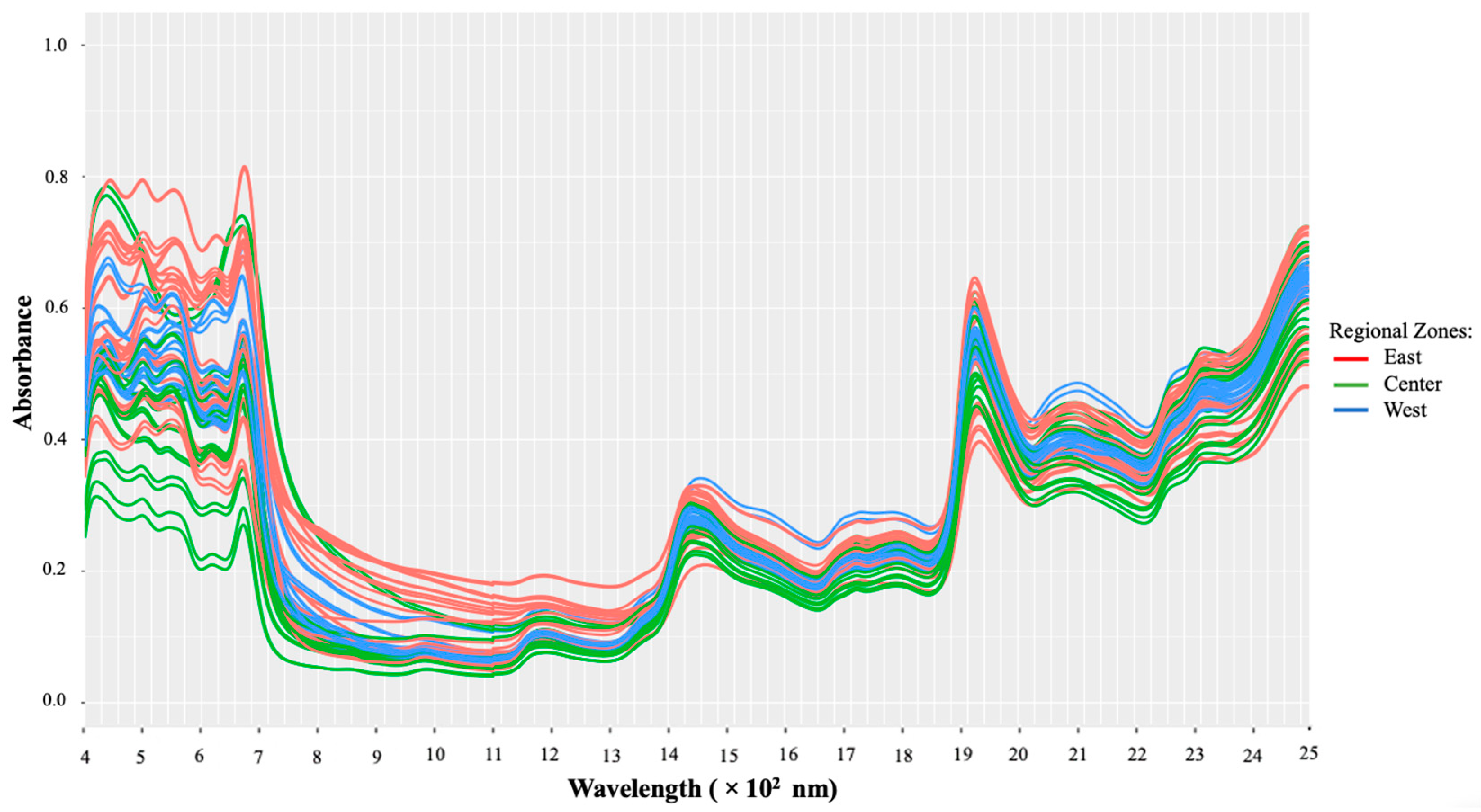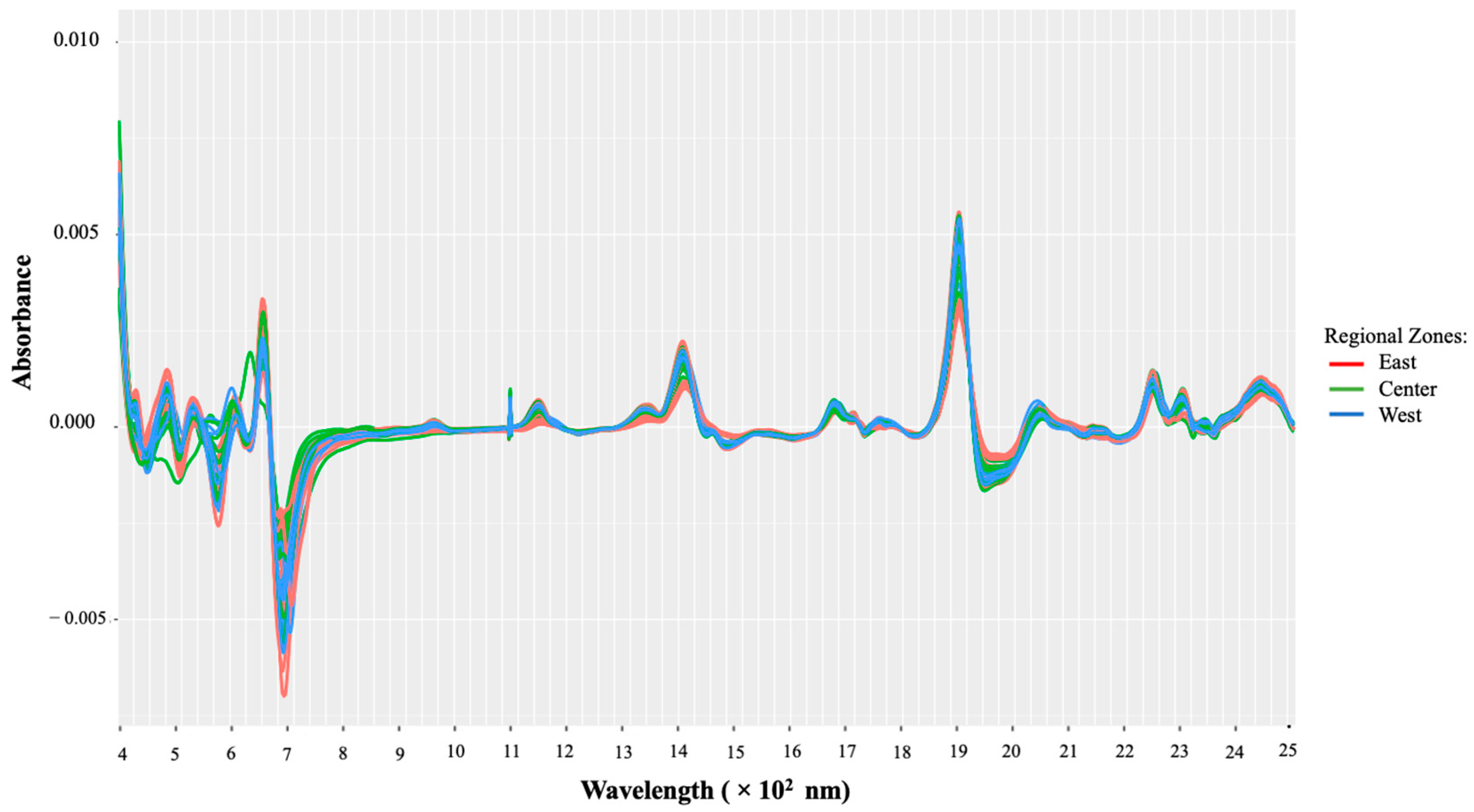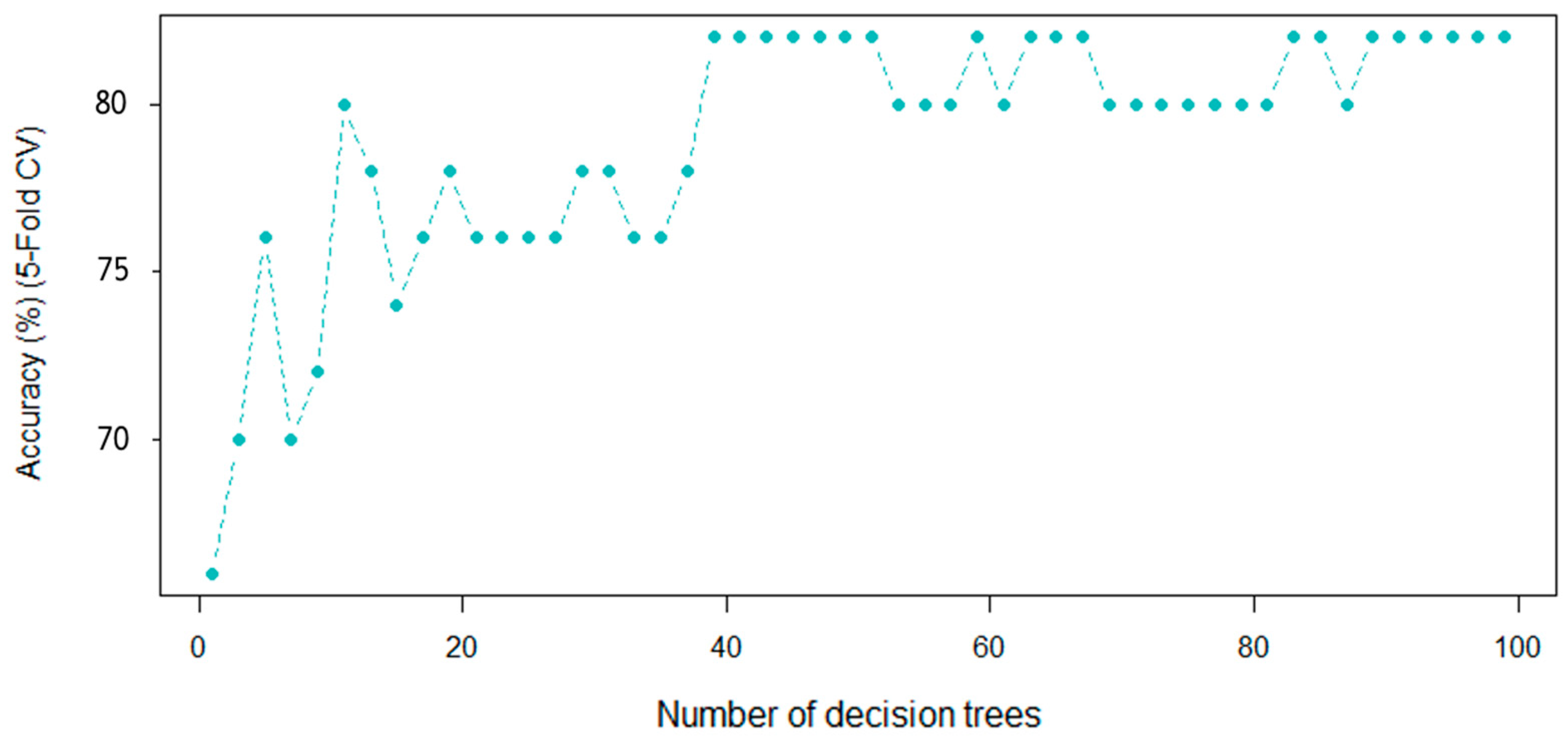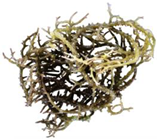A Rapid Method for Authentication of Macroalgae Based on Vis-NIR Spectroscopy Data Combined with Chemometrics Approach
Abstract
:1. Introduction
2. Materials and Methods
2.1. Samples
2.2. Vis-NIR Spectrum Acquisition
2.3. Multivariate Data Analysis
3. Results and Discussion
3.1. Vis-NIR Data Spectra
3.2. Exploratory Analysis
3.3. Supervised Techniques
3.3.1. Classification Based on a Support Vector Machine (SVM)
3.3.2. Classification Based on a Random Forest (RF)
3.4. Webpage Development
4. Conclusions
Supplementary Materials
Author Contributions
Funding
Institutional Review Board Statement
Informed Consent Statement
Data Availability Statement
Acknowledgments
Conflicts of Interest
References
- Fisheries and Aquaculture. FAO Global Fishery and Aquaculture Production Statistics (FishStatJ). Available online: www.fao.org/fishery/statistics/software/fishstatj/en (accessed on 13 October 2022).
- Farobie, O.; Novi, S.; Edy, H.; Apip, A.; Asep, B.; Navid, R.M.; Yukihiko, M.; Surachai, K. The potential of sustainable biogas production from Macroalgae in Indonesia. In Proceedings of the 4th International Conference on Agricultural Engineering for Sustainable Agriculture Production, Bogor, Indonesia, 11 October 2021. [Google Scholar]
- Diharmi, A.; Fardiaz, D.; Andarwulan, N.; Heruwati, E.S. Chemical and Physical Characteristics of Carrageenan Extracted from Eucheuma Spinosum Harvested from Three Different Indonesian Coastal Sea Regions. Phycological. Res. 2017, 65, 256–261. [Google Scholar] [CrossRef]
- Badan Pusat Statistik (BPS). Statistics of Marine and Coastal Resources; Badan Pusat Statistik Press: Jakarta, Indonesia, 2017; p. 46.
- Palmieri, N.; Forleo, M.B. The Potential of Edible Seaweed within the Western Diet. A Segmentation of Italian Consumers. Int. J Gastron Food Sci. 2020, 20, 100202. [Google Scholar] [CrossRef]
- Véliz, K.; Toledo, P.; Araya, M.; Gómez, M.F.; Villalobos, V.; Tala, F. Chemical Composition and Heavy Metal Content of Chilean Seaweeds: Potential Applications of Seaweed Meal as Food and Feed Ingredients. Food Chem. 2022, 398, 133866. [Google Scholar] [CrossRef] [PubMed]
- Verma, P.; Kumar, M.; Mishra, G.; Sahoo, D. Multivariate Analysis of Fatty Acid and Biochemical Constitutes of Seaweeds to Characterize Their Potential as Bioresource for Biofuel and Fine Chemicals. Bioresour Technol. 2017, 226, 132–144. [Google Scholar] [CrossRef]
- Fernández-Segovia, I.; Lerma-García, M.J.; Fuentes, A.; Barat, J.M. Characterization of Spanish Powdered Seaweeds: Composition, Antioxidant Capacity and Technological Properties. Food Res. Int. 2018, 111, 212–219. [Google Scholar] [CrossRef]
- Langford, A.; Zhang, J.; Waldron, S.; Julianto, B.; Siradjuddin, I.; Neish, I.; Nuryartono, N. Price Analysis of the Indonesian Carrageenan Seaweed Industry. Aquaculture 2022, 550, 737828. [Google Scholar] [CrossRef]
- Lama, G.F.C.; Errico, A.; Pasquino, V.; Mirzaei, S.; Preti, F.; Chirico, G.B. Velocity Uncertainty Quantification Based on Riparian Vegetation Indices in Open Channels Colonized by Phragmites Australis. J. Ecohydraulics 2022, 7, 71–76. [Google Scholar] [CrossRef]
- Khan, M.A.; Sharma, N.; Lama, G.F.C.; Hasan, M.; Gerg, R.; Busico, G.; Alharbi, R.S. Three-Dimensional Hole Size (3DHS) Approach for Water Flow Turbulence Analysis over Emerging Sand Bars: Flume-Scale Experiments. Waters 2022, 14, 1889. [Google Scholar] [CrossRef]
- Lama, G.F.C.; Sadeghifar, T.; Azad, M.T.; Sihag, P.; Kisi, O. On the Indirect Estimation of Wind Wave Heights over the Southern Coasts of Caspian Sea: A Comparative Analysis. Water. 2022, 4, 843. [Google Scholar] [CrossRef]
- Cetó, X.; Sánchez, C.; Serrano, N.; Díaz-Cruz, J.M.; Núñez, O. Authentication of Paprika Using HPLC-UV Fingerprints. LWT 2020, 124, 109153. [Google Scholar] [CrossRef]
- Wang, P.; Chen, J.; Chen, L.; Shi, L.; Liu, H. Characteristic Volatile Composition of Seven Seaweeds from the Yellow Sea of China. Mar. Drugs 2021, 19, 192. [Google Scholar] [CrossRef] [PubMed]
- Mutiarahma, S.; Putra, V.G.P.; Chaniago, W.; Carrera, C.; Anggrahini, S.; Palma, M.; Setyaningsih, W. Uv-Vis Spectrophotometry and Uplc–Pda Combined with Multivariate Calibration for Kappaphycus Alvarezii (Doty) Doty Ex Silva Standardization Based on Phenolic Compounds. Sci. Pharm. 2021, 89, 47. [Google Scholar] [CrossRef]
- Hashemi-Nasab, F.S.; Parastar, H. Vis-NIR Hyperspectral Imaging Coupled with Independent Component Analysis for Saffron Authentication. Food Chem. 2022, 393, 133450. [Google Scholar] [CrossRef]
- Burns, R.L.; Alexander, R.; Snaychuk, L.; Edwards, J.C.; Fitzgerald, N.; Gao, P.; Quan, D.; Douvris, C.; Vaughan, T.; Bussan, D.D. A Fast, Straightforward and Inexpensive Method for the Authentication of Baijiu Spirit Samples by Fluorescence Spectroscopy. Beverages 2021, 7, 65. [Google Scholar] [CrossRef]
- Yang, Q.; Tian, S.; Xu, H. Identification of the Geographic Origin of Peaches by VIS-NIR Spectroscopy, Fluorescence Spectroscopy and Image Processing Technology. J. Food Compos. Anal. 2022, 114, 104843. [Google Scholar] [CrossRef]
- Barea-Sepúlveda, M.; Ferreiro-González, M.; Calle, J.L.P.; Barbero, G.F.; Ayuso, J.; Palma, M. Comparison of Different Processing Approaches by SVM and RF on HS-MS ENose and NIR Spectrometry Data for the Discrimination of Gasoline Samples. Microchem. J. 2022, 172, 106893. [Google Scholar] [CrossRef]
- Calle, J.L.P.; Falatová, B.; Aliaño-González, M.J.; Ferreiro-González, M.; Palma, M. Machine learning approaches over ion mobility spectra for the discrimination of ignitable liquids residues from interfering substrates. Talanta Open 2022, 6. [Google Scholar] [CrossRef]
- Calle, J.L.P.; Ferreiro-González, M.; Ruiz-Rodríguez, A.; Barbero, G.F.; Álvarez, J.; Palma, M.; Ayuso, J. A Methodology Based on Ft-Ir Data Combined with Random Forest Model to Generate Spectralprints for the Characterization of High-Quality Vinegars. Foods 2021, 10, 1411. [Google Scholar] [CrossRef]
- Pérez Calle, J.; Ferreiro-González, M.; Aliaño-González, M.; Espada-Bellido, E.; Palma, M.; Barbero, G.F. Quality control of honey by visible and near infrared spectroscopy (Vis-NIRS) and headspace-ion mobility spectrometry (HS-IMS). In Proceedings of the 3rd International Electronic Conference on Environmental Research and Public Health—Public Health Issues in the Context of the COVID-19 Pandemic, Basel, Switzerland, 11–25 January 2021. [Google Scholar]
- Rahi, S.; Mobli, H.; Jamshidi, B.; Azizi, A.; Sharifi, M. Achieving a Robust Vis/NIR Model for Microbial Contamination Detection of Persian Leek by Spectral Analysis Based on Genetic, IPLS Algorithms and VIP Scores. Postharvest. Biol. Technol. 2021, 175, 111413. [Google Scholar] [CrossRef]
- Bai, S.; Qin, D.; Chen, Z.; Wu, S.; Tang, S.; Gao, L.; Wang, P. Geographic Origin Discrimination of Red Swamp Crayfish Procambarus Clarkii from Different Chinese Regions Using Mineral Element Analysis Assisted by Machine Learning Techniques. Food Control 2022, 138, 109047. [Google Scholar] [CrossRef]
- Calle, J.L.P.; Ferreiro-González, M.; Ruiz-Rodríguez, A.; Fernández, D.; Palma, M. Detection of Adulterations in Fruit Juices Using Machine Learning Methods over FT-IR Spectroscopic Data. Agronomy 2022, 12, 683. [Google Scholar] [CrossRef]







| Species | Cultivation Site | Origin | Regional Zone | Sample Appearance |
|---|---|---|---|---|
| Kappaphycus alvarezii | Geranting Island | Sumatera | Western |  |
| Euchema spinosum | Jeneponto | Celebes | Eastern |  |
| Gracilaria changii | Kutuh | Bali | Central |  |
| Model | Parameters | Accuracy (%) | ||
|---|---|---|---|---|
| Training Set | Test Set | 5-Fold Cross-Validation | ||
| Support Vector Machine (SVM) | Penalty Factor (C) = 1 | 100 | 100 | 82 |
| Kernel Parameter (γ) = 0.000976 | ||||
| Number of Support Vectors = 50 | ||||
| Random Forest (RF) | mtry = 64.7 | 100 | 80 | 82 |
| ntree = 100 | ||||
Disclaimer/Publisher’s Note: The statements, opinions and data contained in all publications are solely those of the individual author(s) and contributor(s) and not of MDPI and/or the editor(s). MDPI and/or the editor(s) disclaim responsibility for any injury to people or property resulting from any ideas, methods, instructions or products referred to in the content. |
© 2022 by the authors. Licensee MDPI, Basel, Switzerland. This article is an open access article distributed under the terms and conditions of the Creative Commons Attribution (CC BY) license (https://creativecommons.org/licenses/by/4.0/).
Share and Cite
Gumansalangi, F.; Calle, J.L.P.; Barea-Sepúlveda, M.; Manikharda; Palma, M.; Lideman; Rafi, M.; Ningrum, A.; Setyaningsih, W. A Rapid Method for Authentication of Macroalgae Based on Vis-NIR Spectroscopy Data Combined with Chemometrics Approach. Water 2023, 15, 100. https://doi.org/10.3390/w15010100
Gumansalangi F, Calle JLP, Barea-Sepúlveda M, Manikharda, Palma M, Lideman, Rafi M, Ningrum A, Setyaningsih W. A Rapid Method for Authentication of Macroalgae Based on Vis-NIR Spectroscopy Data Combined with Chemometrics Approach. Water. 2023; 15(1):100. https://doi.org/10.3390/w15010100
Chicago/Turabian StyleGumansalangi, Frysye, Jose L. P. Calle, Marta Barea-Sepúlveda, Manikharda, Miguel Palma, Lideman, Mohamad Rafi, Andriati Ningrum, and Widiastuti Setyaningsih. 2023. "A Rapid Method for Authentication of Macroalgae Based on Vis-NIR Spectroscopy Data Combined with Chemometrics Approach" Water 15, no. 1: 100. https://doi.org/10.3390/w15010100
APA StyleGumansalangi, F., Calle, J. L. P., Barea-Sepúlveda, M., Manikharda, Palma, M., Lideman, Rafi, M., Ningrum, A., & Setyaningsih, W. (2023). A Rapid Method for Authentication of Macroalgae Based on Vis-NIR Spectroscopy Data Combined with Chemometrics Approach. Water, 15(1), 100. https://doi.org/10.3390/w15010100








